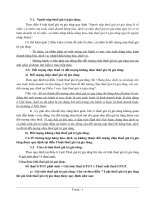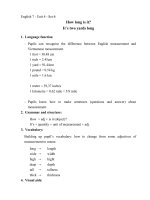Bài giảng what is biodiversity
Bạn đang xem bản rút gọn của tài liệu. Xem và tải ngay bản đầy đủ của tài liệu tại đây (2.52 MB, 41 trang )
What is Biodiversity?
Biodiversity is:
the variety of life on Earth at all its levels,
from genes to ecosystems, and the ecological
and evolutionary
processes that sustain it.
Source: ©AMNH-CBC
Dimensions of biodiversity
Genetic
component
Spatial
component
Functional
component
Temporal
component
within individuals
communities
daily
within
populations
ecosystems
e.g. reproductive
behavior,
predation,
parasitism
between
populations
between species
seasonal
landscapes
annual
ecoregions
geological or
evolutionary
biogeographic
regions
Hierarchy of Biodiversity
Ecological
diversity
Biomes
Bioregions
Landscapes
Ecosystems
Habitats
Niches
Population
Organismal
diversity
Phyla
Classes
Orders
Families
Genera
Species
Subspecies
Population
Individuals
Genetic
diversity
Population
Individuals
Chromosomes
Genes
Nucleotides
Source: Yves Samyn
Hierarchy of
Biodiversity
Elements of biodiversity form nested hierarchies
Source: Yves Samyn
Genetic Diversity
The variation in the
nucleotides, genes,
chromosomes, or
whole genomes of
organisms
Source: Human Genome Project, Department of Energy
Variation in genome size
Source: U.S. Dept. of Energy, Human Genome Project
/>
A greater total number of genes
might not correspond with a
greater complexity in the
anatomy and physiology of
the organism
Species
Organism
common name
Number of genes
in genome
Reference
Arabidopsis
thaliana
thale cress
25,498
Oryza sativa
(indica-cultivar
subgroup)
Caenorhabditis
elegans
Indian rice
46,022-55,615
Arabidopsis
Genome Initiative
(2000)
Yu et al. (2002)
nematode
19,000
Drosophila
melanogaster
fruit fly
13,600
Homo sapiens
human
ca. 30,000-40,000
C. elegans
Sequencing
Consortium
(1998)
Adams et al.
(2000)
International
Human Genome
Sequencing
Consortium
(2001)
Phenotypic Diversity
Phenotype - the physical constitution of an organism that
results from its genetic constitution (genotype) and the
action of the environment on the expression of the genes.
Thus, phenotypic
diversity refers to
variation in the
physical traits of the
organism.
Domroese ©AMNH-CBC
An Example of Genetic Variation
Source: ©AMNH-CBC
Morphological diversity within and
between natural populations: An example
Morphological diversity within and between
natural populations: Vietnam’s examples
Nguyen et al. 2009
A population is:
• a group of individuals of the same species that share
aspects of their genetics or demography more closely with
each other than with other groups of individuals of that
species
• a more practical way of defining a population and
measuring its diversity is by the space it occupies. Thus a
population may be defined as a group of individuals of
the same species occupying a defined area at the same
time (Hunter, 2002).
Cryptic Species
• taxonomically cryptic
species look very
similar to other species
• may be misidentified
(and hence overlooked
as being a different
species).
Source: Bain ©AMNH-CBC
Population Diversity
• Variation in the quantitative and spatial
characteristics between populations
Proportion of total genetic variation within
species due to genetic differences between
geographic populations (from Avise, 1994)
Group
Mammals
Birds
Reptiles
Amphibians
Fishes
Insects
Crustaceans
Mollusks
Population Differences
0.242
0.076
0.258
0.315
0.135
0.097
0.169
0.263
Importance of population
variation
Loss of isolated populations along with
their unique component of genetic
variation is considered by some scientists
to be one of the greatest but most
overlooked tragedies of the biodiversity
crisis.
Species concepts
• Morphological
• Biological
• Phylogenetic
– Each definition of species produces a different
count of species.
– Therefore, each definition has a different effect
on how we plan conservation.
Species diversity vs. richness
•Species richness: the number of species present in a given area
• Species diversity: species number weighted by measure of importance, such as
abundance, productivity or size
For example:
Shannon’s diversity index (H) = -i ln i
i is the proportion of the total number of specimens of species i expressed
as a proportion of the total number of specimens for all species in the
ecosystem.
Many people use the term “species diversity” when they mean species richness
RICHNESS vs. EVENNESS
250
Ecosystem A
SR = 4
H' = 1.3086
SE = 0.94
Ecosystem B
Ecosystem C
SR = 3
H' = 1.0807
SE = 0.98
SR = 3
H' = 1.0323
SE = 0.94
# Individuals of Each Species
200
150
Spe cie s 1
Spe cie s 2
Spe cie s 3
Spe cie s 4
100
50
0
Ecosystem
Adapted from: Hunter, M. Jr. 2002. Fundamentals of Conservation
Biology. Second Edition. Blackwell Science, Massachusetts, U.S.A.
Developing this idea further
• An ecosystem with representative species from
many different higher taxa present (e.g from
different families or orders) possess more
taxonomic or phylogenetic diversity than
another with fewer higher taxa but many more
species.
• Marine ecosystems frequently have more
different phyla but fewer species than
terrestrial ecosystems; i.e. higher taxonomic
diversity but lower species diversity.
Community Diversity
• Variation in the groups of populations
and species that share an environment
Ecosystem Diversity
• An ecosystem is a community plus the physical
environment that it occupies at a given time.
Some examples of ecosystems
–
–
–
–
–
coral reefs
tallgrass prairie
coastal wetlands
old-growth forest
tropical rainforest
Mangroves,
Belize
Source: Harrison ©AMNH
Source: Brumbaugh ©AMNH-CBC
Inter-species interactions
underpin ecosystem diversity
• There are very many potential interactions among
species, such as:
– predation,
– competition,
– parasitism,
– mutualism
• Some of these involve very close ecological and
evolutionary associations between the organisms and
are an important component of community and
ecosystem biodiversity
– consider for example plant pollinators and seed dispersers
Examples of distinct
communities and ecosystems
• Species associated with:
ripening figs in a tropical
forest,
• Species clustered around
a hydrothermal vent on
the ocean floor,
• Species in the spray zone
of a waterfall,
Source: ©AMNH
• Species under warm
stones in the alpine zone
on a mountaintop.









